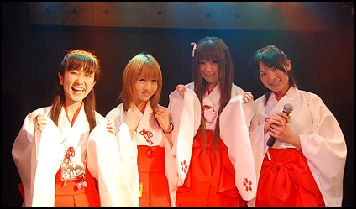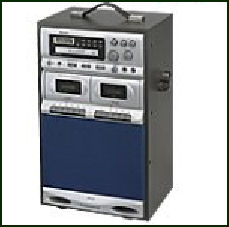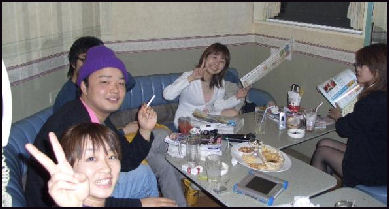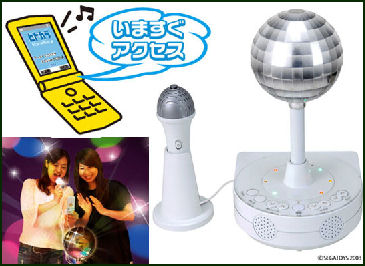KARAOKE AND SINGING IN JAPAN

Shinto shrine girls at a karaoke Kaoroke is a Japanese invention. The word is a combination of the Japanese words for "empty" (“kara”) and "orchestra" (“oke”). Particularly popular in Asia and Asian neighborhoods all over the world, karaoke bars allow patrons to sing their favorite songs along with a synthesized instrumental version of the song with no voice track. Urban legend has it that karaoke means “tone-deaf.”
Karaoke singers sings into a microphone as the lyrics flash across a video screen, often while swimming squids or naked women are flashed in the background. The singer's voice is often distorted with a vibrato warble and sometimes a number appears on the video screen after the song is over. This "score" is usually based more on loudness than singing ability. In any case, even horrible singers are generally applauded by the Japanese for their effort.
Like other Asians, the Japanese enjoy singing. Karaokes are found in every town and on almost every city block; popular television shows often feature actors and sumo wrestlers singing karaoke-style enka hits; and parties are often a succession of guests coming to a microphone and singing songs. Japanese often ask people they meet: What’s your “ohaku”? “Ohaku” means your “one best song.”
Singing is a way people relax. The tension of business negotiations is often relieved by a visit to a karaoke club, after which everyone feels better and the deal is made. One survey found 83 percent of teenage girls and 63 percent of teenage boys sing karaoke. Many Japanese like to sing alone. It s not unusual for an individual to go to a karaoke by himself or herself.
Book: “Karaoke: The Global Phenomenon” by Zhou Xun and Francesca Tarocco (Reaktion Books, 2007) is a sociological study using the Mass-Observation research method in which minutiae of people's daily life is observed in great detail to gauge popular opinion of the day. Zhou Xun and Francesca Tarocco travel the globe using this method to the study karaoke.
Good Websites and Sources: Japan Visitor japanvisitor.com ; How to Sing Karaoke worldhum.com ; History of Karaoke associatedcontent.com ; Time magazine Profile on Karaoke Inventor time.com ; Karaoke Etiquette and Tips brianx.com/nightlife
Inventor of Karaoke
The karaoke machine was invented in 1971 by a 31-year-old former drummer named Daisuke Inoue, who plugged an eight track tape player into an amplifier.
Inoue was named by Time Magazine as one of the most important Asians of the 20th century and was awarded the Ig Nobel Peace Prize in 2004 “for providing an entirely new way for people to learn to tolerate each other.” Born in Osaka in 1940, he played the drums in high school and ran a sidewalk pancake stand for a while..
Inoue was never recognized as the inventor of karaoke until 1996 when was tracked down by a Singaporean documentary crew. He never used a karaoke machine himself until his 59th birthday in 1999. The last time anyone checked he was living at a second-story walk up in a suburb of Osaka.
Invention of Karaoke in Japan

Karaoke machine In 1970, Inoue opened his own bar where he played drum with a six-member band. The band was terrible but a loyal group of businessmen liked their slow style of playing which allowed them to sing along.
One night the president of small steel company asked Inoue to play for him on an overnight trip to a hot spring resort. Inoue couldn't leave his band so he gave the president a tape of his accompaniment for a few famous songs, which the president could sing along with.
After that, Inoue thought that if a company president enjoyed singing to tapes of drumming then other people out there would like singing to tapes of popular songs played by a complete band. He and some friends made 11 home-made machines from used eight track tape players and amplifiers and began leasing the machines to bars in Kobe.
The first karaoke was a television-size eight track player fitted with an amplifier, coin box and microphone called the “8-Juke.” It played a sing along sound track when a ¥100 coin was inserted
Inoue, Karaoke, Money and Success
Despite karaoke's huge success Inoue never made much money because he failed to take out a patent on his invention. His idea was taken over by large companies and his own company eventually went bankrupt. The only patent he owned was for plastic covered songbooks used by karaoke customers to choose songs. Inoue has said on a number of occasions that he has no regrets for failing to take out a patent on his idea.
The only Inoue money makes from karaoke today is from a concoction keeps rats and cockroaches out of karaoke machines. But he is not bitter, and not out of ideas. He told Time in 1999 he wanted to set up a "cradle-to-grave training for cats and dogs."
Inoue said he takes pride in helping the Japanese open up. He told Time the Japanese " are said to be shy and poor at expressing themselves in public, But give a guy a microphone, and the same man who has trouble getting out a wedding speech never wants to stop."
Karaoke is also credited with helping to bringing more equality to Japanese hierarchal corporate structure, helping Japanese learn English and providing an icebreaker for people meeting for the first time. It also provided these service for people around the world.
Spread of Karaoke

Partying in the karaoke People liked Inoue’s invention and later it was introduced into other bars in the Osaka-Kobe area. The first commercial karaoke machine was sold by the Clarion Co. in 1976.
Early machines consisted of an amplifier, speaker, microphone and tape player that played eight track tapes with voiceless accompanying music. People who couldn't remember the words to the songs referred to thick books containing the lyrics.
In 1982, Pioneer Electronic Corp, introduced laser disc karaokes that played voiceless music and video scenes accompanied by the words of the songs, making the lyric books obsolete and giving the industry a big boost. The music and video in karaokes today come mainly from video CDs. The first karaoke box debuted in a converted Japanese freight car in a rice field in 1984.
There are basically two kinds of karaokes: karaoke boxes designed to accommodate a small group in a room; and karaoke bars, lounges and clubs, where people sing in front of a large audience that includes strangers. These days the former is more popular in Japan and Asia while the latter is more popular in the West.
Because of the closed nature of "box” versions, these are often regarded a havens for prostitution, drug abuse and juvenile delinquency. Many regulations and laws have been put into effect that inlcude curfews for minors and age limits for admission.
Karaoke in Japan
Karaoke reached the height of its popularity in Japan in the mid 1990s when about half the population of Japan sang at least one song at one of the nation’s 135,000 karaokes.
Karaoke is a $10 billion a year industry in Japan. About 280,000 of Japan's 350,000 bars and nightclubs have karaokes. Plus, there are about 140,000 "singing rooms" that can be rented by the hour and are especially popular among young people who don't frequent bars (sometimes individuals even go to them alone).
According to one estimate half of Japan's 125 million people enjoy karaoke, and 16.5 million times a day somebody in Japan sings into a karaoke microphone either at home, in a park, or in bar or singing room. One senryu (humorous haiku) goes: “”Sarariman/ Utau toki dake/ “My Way.”“ (‘salaryman. Does it “My Way”/ only when he sings”).
Karaoke Etiquette in Japan

Karaoke date In Japan a distinction is made between “singing-with-a-friend-on-a-Saturday-night” and “tsukiai” after-work socializing, a de facto obligation among workers to promote interdepartmental bonds.
Some rules for the latter described in a Japanese woman’s magazine and mentioned in the book “Karaoke: The Global Phenomenon” are: 1) “Listen respectfully to the boss”; 2) “Take care not to sing the boss’s favorite song as it is likely he will not be able to sing many different songs”; 3) “Avoid sexy songs that are likely to offend senior office ladies”; 4) Wear a suit rather than a sexy dress out of respect for senior office ladies.”
Foreigners should be careful at some Japanese karaokes. Many are hostess bars where male patrons are surrounded by young women who have a few drinks, and then stick the customer with an outrageous bill, with yakuza gangsters nearby to make sure they pay up one way or another.
Karaoke Booths Become More Than Just Singing Rooms
In March 2012, the Yomiuri Shimbun reported: “Karaoke complexes dot the entire country. But recently, these buildings have changed from a mere place to sing and party, to a multipurpose space. Operators are finding ways to make the most of cozy karaoke boxes to meet customers' demand. Nowadays, a karaoke complex is a familiar "universal space" in everyday life. [Source: Yomiuri Shimbun, March 16, 2012]
A karaoke studio located on the fifth floor of a multi-tenant building in Kanda, Tokyo, has a total of 24 rooms. Each room is slightly bigger than a phone booth and is equipped with a desk, chair, TV monitor, electronic song catalogue and a microphone complete with its own stand. Rooms offered exclusively to women are also available. At the end of November, the One-Kara Kanda-Ekimae branch became the industry's first one-man karaoke complex. Customers are given headphones, which are connected to the microphone they sing into. "I came here to practice as I'm not comfortable singing in front of people. I can try out my favorite songs here without constraint," said a 29-year-old company employee.
Karaoke booths--often called a "karaoke box" in Japanese as each unit is a private, partitioned room--first appeared in 1985 and became immensely popular in the 1990s. At the time, these karaoke complexes gained a negative reputation as a place for young people to go on drinking sprees or hang out after missing the last train. Many rooms smell of smoke, and it is often possible to hear noises from neighboring rooms.
Since then, the environment in karaoke booths has improved. Rooms are now soundproofed and neatly furnished. These efforts have helped broaden the customer base. Now, karaoke is enjoyed by not only young people, but people of all ages. The average person spends about 1,900 yen per visit, including fees for drinks and food, and stays for about 2-1/2 hours.
Pasela Resorts--which runs about 20 karaoke complexes in the Tokyo metropolitan area--provides its party rooms in office districts for corporate meetings. During the day, a huge screen is used for presentations. At night, it's used for singing. Kansai-based Jankara offers rooms furnished with household sofas and allows customers to rent DVD players so they can use the space for various purposes other than just singing. Karaoke no Tetsujin, which operates 54 complexes primarily in Tokyo, offers four livehouse-esque rooms at each complex. These rooms have a total capacity of 100 people and are equipped with a mirror ball.
"Karaoke boxes help society create a new culture using private rooms," said Kansai Gaidai University Prof. Yoichiro Maekawa, a karaoke culture expert. According to Maekawa, karaoke complexes are now casual meeting places not unlike cafes or community centers. "Karaoke boxes provide cozy units where people can even eat. Anyone, regardless if they are alone or with a group of people, can visit casually and easily. The entrance fee is inexpensive and you can use it during the daytime. You don't even have to sing if you don't want to," Maekawa said. "Actually, its hard to find spaces like that, which is why I think people are starting to find value in such places.”
Decline of Karaoke in Japan
The number of people visiting karaoke places has been steadily declining for years. In 2012, an estimated 46.5 million people visit karaoke booths at least once a year, according to the All-Japan Karaoke Industrialist Association. The figure has decreased from 58.9 million in fiscal 1994. According to Maebashi-based Koshidaka Co., which operates One-Kara chains, about 20 percent of karaoke enthusiasts go to sing on their own. These solo customers say they come alone "to relieve stress," or "to secretly get better at singing." [Source: Yomiuri Shimbun, March 16, 2012]
By the early 2000s, there 16 percent less singing rooms and they were reporting a 20 percent decrease in business from what they were getting in the 1990s. The decline has been attributed to company employees having less free time, young people having less money because of the recession and spending what money they do have to pay off cell phone bills.
In an efforts to win back customers bars have installed machines that allowed people to join or form online networks and make their own web sites that among other things list their computer-generated scores for their favorite songs,
A survey un 2007, counted 6,378 karaokes in Japan, Many of them are kind of sleazy and run down, The same survey found that 45 percent if them violated fire laws.
Karaoke Around the World

Karaoke party at home Karaoke is credited with helping to bring back singing — once a popular pastime and social activity that declined with competition from movies and television.
In the United States, where more and more non-Asians are discovering the joys of karaoke, the rowdy belt-it-out and get-loud-and-obnoxious-style of some Americans often clashes with the more laid-back and polite Asian-style of karaoke singing.
Two months before his suicide Dennis Potter, the author of the play “Karaoke”, told Channel 4 in Britain, “there is music , and you have a little line, and you can sing it, and everything is written for you, and that is what life feels like for a lot of people.”
Decline of Karaoke Worldwide
Karaoke reached its peak in the United States around 2002 when the sale of karaoke machines and software exceeded $200 million. By the late 2000s karaoke was in steep decline, with the sale of karaoke machines and software falling below $40 million in 2008. The decline was blamed on a shift to video games, on streaming services and a decline in entertainment expenses due to economic hard times. Karaoke record companies are squeezed between high licensing fees and illegal online downloads. On top of that of the karaoke machine was named by consumers in one survey in 2009 as the world’s most irritating gadget ahead of mobile phones and alarm clocks.
Piracy has dealt the most crippling blow the karaoke industry. Most karaoke jockeys who play karaoke songs at parties these days use $300 hard drives that hold thousands of pirated tracks rather than $18 CDs that typically only have nine songs. Tom Viveiros of the Karaoke Alliance of America told the Los Angeles Times, “Piracy is 90 percent of the problem and its going to end up being the demise of the karaoke industry as we know it. There are more venues with karaoke night than we’ve seen in 15 years, but with few exceptions they’re all stealing music.”
These days there are karaoke apps for iPhones, karaoke pages on MySpace and variety of games and things that can be used on Nintendo and Sony handheld devises and consoles. Popular phone applications include Karaoke Callout and Karaokini.. Among the popular karaoke streaming sites are the Karaoke Channel Online from Stingray Digital. With the Karaoke Revolution game, singers can create their own avatars or animated figures. With the Rock Band series you can became one of the Beatles,On Da Mic caters to hip hop fans while SingStar is for county music fans.
Image Sources: 1) Ray Kinnane 2) Japan Visitors 3) 4) 6) Tokyo Pictures, 5) xorsyst blog
Text Sources: New York Times, Washington Post, Los Angeles Times, Daily Yomiuri, Times of London, Japan National Tourist Organization (JNTO), National Geographic, The New Yorker, Time, Newsweek, Reuters, AP, Lonely Planet Guides, Compton’s Encyclopedia and various books and other publications.
Last updated January 2013
